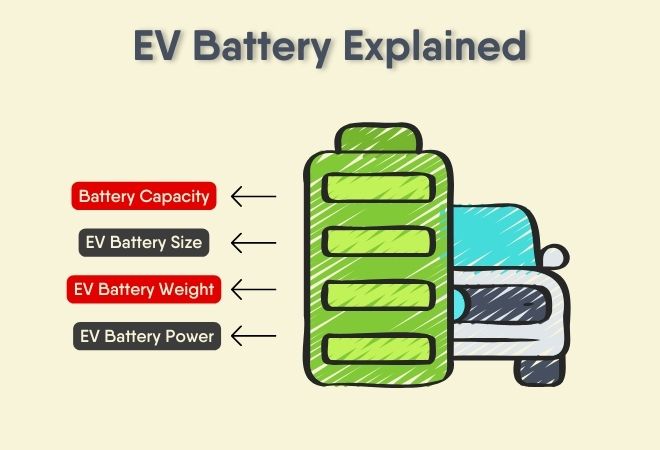Menu
Menu


Updated on Feb 2, 2024 | 6 min read
EV Battery is the Core part of any Electric Vehicle. It has various features like battery capacity, size, weight, power, etc that impact the Electric Vehicles’s performance and life. In this blog, we will understand the features and their impacts on EVs.
Connect with 1C for expert advice on EV chargers
An Electric Vehicle Battery is a rechargeable energy storage device used to power the electric motors and auxiliary systems in electric vehicles. EV batteries are lithium-ion batteries known for their high energy density and rechargeability. They store electrical energy generated from regenerative braking or external sources such as charging stations. EV batteries play an important role in determining the vehicle’s range, performance, and overall efficiency, which makes them a key component of electric mobility.
Ev Batteries are different from other Batteries in MAny ways listed below:
Connect with 1C for expert advice on EV chargers
The Main characteristics associated with EV battery are:
Battery capacity, also known as energy capacity, refers to the amount of energy a battery can deliver over a specific period. It’s measured in kilowatt-hours (kWh) and calculated by multiplying the battery’s voltage by its ampere-hours (Ah).
For example, if a battery has a voltage of 12 volts and an ampere-hour rating of 50 Ah, its capacity would be 600 watt-hours (Wh) or 0.6 kWh (12V x 50Ah = 600Wh = 0.6 kWh). This capacity determines the energy available to power electric motors and other components in devices like electric vehicles.
The weight of an EV battery significantly contributes to the overall vehicle weight. Typically, passenger EVs range from 600kg to 2600kg in gross weight, with battery weights varying from 100kg to 550kg. A more powerful battery correlates with a greater weight, as it contains more energy. As vehicle weight increases, more energy is needed to move it. Energy density, measured in Watthours per kilogram (Wh/kg), signifies the amount of energy a battery holds relative to its weight.
The energy density of an electric vehicle (EV) battery significantly influences its performance. Higher energy density means more energy stored per unit weight of the battery, leading to increased driving range or reduced weight for the same range.
For example, if an EV with a battery having an energy density of 200 Wh/kg achieves a range of 300 miles, upgrading to a battery with 300 Wh/kg could increase the range to 450 miles without increasing the battery’s weight. This shows how energy density improvements directly impact electric vehicles’ performance and usability.
The size of an electric vehicle’s battery holds significant importance. Volumetric energy density refers to the amount of energy stored within a specific volume, measured in Wh/litre. Higher volumetric energy density allows for better range without significantly increasing the battery’s size. This improvement enables savings in space, weight, and manufacturing costs for the vehicle. In essence, batteries with higher volumetric density contribute to building more compact and efficient electric vehicles.
The C-rating indicates the rate at which a battery can be charged or discharged relative to its capacity. For instance, consider a battery with a capacity of 50 kWh. If it’s charged at a 1C rate, it’s charged at a rate that fills the battery’s full capacity in one hour, so 50 kW. Charging at a higher rate, like 2C, would mean it charges in half the time, i.e., 30 minutes, with a power output of 100 kW. Conversely, a lower rate, say C/2, would mean it takes two hours to charge, with a power output of 25 kW.
Power in an electric vehicle plays a crucial role in providing acceleration and maintaining speed. While mechanically, power is the result of torque and rpm, in the electrical domain, it’s determined by voltage and current. Think of it as the fuel flowing from the tank to the engine in a traditional vehicle. Power is measured in watts (W) or kilowatts (kW), representing the instant power flowing through the electrical circuit.
For example, consider the Nissan Leaf, which has a power output of 147 horsepower (HP). This signifies the maximum power the motor can generate and at what rpm/speed it operates optimally.
electric vehicle batteries are important components that determine the range, performance, and efficiency of EVs. Their characteristics, including capacity, size, weight, energy density, C-rate, and power, directly impact the vehicle’s functionality and usability. As technology advances, the improvements in battery energy density and efficiency contribute to the development of more compact, powerful, and cost-effective electric vehicles. With ongoing research and innovation, electric mobility continues to evolve, offering promising solutions for sustainable transportation and reducing reliance on traditional fossil fuel vehicles.
© 2024 Massive Mobility Private Limited. All rights Reserved